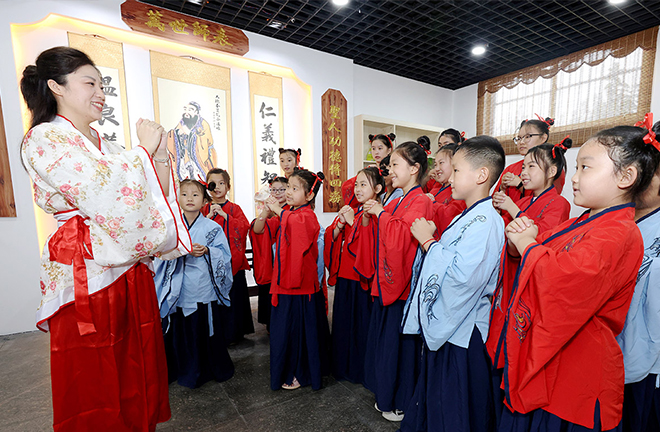Educational space evolves with times

A folk artist teaches traditional etiquette to students, which shows that educational space is no longer limited to physical boundary. Photo: Ji Zhe/CNS
In ancient times, education spaces mainly referred to the venue for education. The venue did not denote the classroom as we understand it today, but any space where educational activities took place.
Educational space in history
For a long time in history, only small portions of educational activities occurred in schools, as specified by the authorities. Many studied in other places as they took field trips together with their mentors after they formally became apprentices through solemn ceremonies, or conducted learning at their homes, or in a particular place owned by clans. There were no permanent fixed sites for education.
Confucius usually lectured in an informal and relaxing atmosphere, not in a stationary place—either sitting at a banquet, or on a block of stone, with students sitting in front of or around the teacher, listening to the lecture.
Dynamic changes in modern times
This situation remained the same until the modern school system was established and the class teaching system was popularized. At that point, educational spaces finally were settled in the form of schools or classrooms.
Over the span of quite a long period of history, we see that people mainly understood educational spaces from the perspective of physical space. At that time, educational space was similar to a kind of “container,” and people could carry out educational activities within the “contained” space. Some scholars refer to this as a spatial concept similar to holding space. Influenced by this concept, people were accustomed to comprehending and forming educational spaces in terms of physical aspects such as environments, configurations, and patterns. Therefore, the concept of educational space overlaps with concept of an educational environment, educational conditions, and educational resources.
After the beginning of the 1990s, people’s understanding of educational spaces began to shift from traditional enclosed spaces to an open space. This concept of an educational space is not limited to the scope of a certain school or classroom with clear physical boundaries. It can be extended to places such as corridors, gardens, factories, and fields to fit the expanding needs of the education. The education space is thus an existential being comprised of factors involved in educational activities such as sites, facilities, and participants. The space is dynamic—it can adjust and shift as educational activities extend, and its fundamental purpose is to ensure teaching activities are conducted in an orderly and effective way.
In other words, educational spaces move beyond pure architectural spaces made of concrete, and begin to pay attention to human needs. The designs of educational spaces are permeated with human wisdom. The dimensions, locations, and patterns in educational spaces not only reflect physical relationships, but also relationships between people. The appearance of office buildings, the design of various campus landscapes, and the choice of campus slogans can be interpreted through a sociological lens. The same can be said of the permutation and distribution of lecture stages, or seats and other divisions of functional space within the micro classroom atmosphere. For example, some parents try to improve their relationships with teachers so that the children can choose their classroom seating and desk mates or occupy more favorable spatial positions according to their own wishes.
Mobile space in digital age
With the advent of cyber society, people’s understanding of educational space has further changed. With the help of information technology, the vast amount of knowledge formed over thousands of years can be stored in various online databases. Everyone can shed the role of mere knowledge receiver and participate in the process of knowledge production. Now, education presents a new context where people can learn everywhere and at any time. The physical boundary between peer communication, work, and study will become more blurred or even completely vanish. The mobile educational space is arising.
As a new form of educational space, there are still many issues to be discussed and solved in constructing and optimizing the mobile educational space. This space also requires society-wide participation from all people who care about education and love learning, to jointly foster its development.
Qi Jun is an associate professor from the Faculty of Education at Qufu Normal University.
Edited by BAI LE

 PRINT
PRINT CLOSE
CLOSE